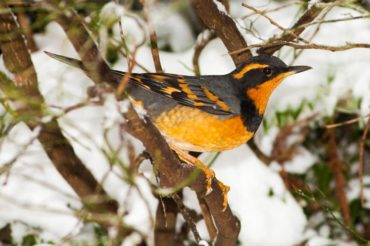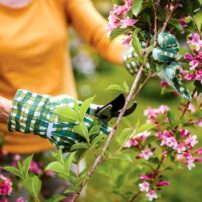
Some people look forward to winter because they enjoy snow sports. Fans of NFL football love the playoffs. Others appreciate a reason to wear flannel and sip hot chocolate by a cozy fire.
Birders see winter as the time to bundle up and grab the binoculars. For birds that breed in the Arctic, a West Sound winter is like the tropics, so many don’t fly any farther south. As a result, waterways are full of waterfowl, shorebirds scurry along shorelines, and backyards are bursting with sparrows.
Other winter birds come to West Sound after spending late spring, summer and early fall in the mountains. One of the most anticipated of these altitudinal migrants is a member of the thrush family and a close relative of the American robin. An iconic species of Northwest forests, the varied thrush is a welcomed reprieve from the gray days of winter.
Populations of varied thrush, or “Alaska robin,” breed as far north as Alaska and Canada and migrate as far as southern California to escape the northern winter. It’s a year-round resident of Washington and Oregon, where it breeds in the mountains and winters in the lowlands.
Although a resident of the West Coast, the occasional varied thrush in need of a new compass will sometimes wander as far east as Nova Scotia. These winter vagrants are a thrill to birders who may have never been to the Northwest. The rare visitors from the West quickly attract a crowd, much like a blue jay wintering in Port Orchard.
In the West Sound region, varied thrushes are fairly common, but somewhat shy, from late fall to early spring. They prefer mature coniferous forests but can be found in virtually any type of lowland forest. By mid-spring, local individuals have departed for their montane and subalpine breeding zones.
With its spectacular slate-gray and orange plumage, the male varied thrush is often featured on calendars and the covers of magazines and field guides. Its trademark black breast-band resembles a strand of onyx pearls. Females don similar field marks in dull orange and brown tones.
Varied thrushes usually nest in the understory of mature high-elevation forests. The female weaves a nest of twigs, lining it with moss and grass and placing it against a tree trunk about 10 feet off the ground. Up to six eggs are laid. Both parents feed the nestlings.
While spending summer in the mountains, varied thrushes primarily eat insects and other arthropods they find by scratching in the leaf litter on the forest floor. When the seasons change and invertebrates become scarce, varied thrushes descend to the lowlands to forage on berries and seeds in the winter.
Although secretive in their breeding zone, varied thrushes in the non-breeding months are known to visit backyards that border wooded areas and offer good dining. Native fruiting shrubs, such as evergreen huckleberry and salal, are appealing to them.
Another way to attract varied thrushes is to offer millet seed by the edge of the forest. Millet works well, as it’s not attractive to rodents or subject to mildew. It’s also inexpensive and sold at local wild bird shops. Millet scattered in appropriate habitat will also attract an assortment of other species, including mourning doves and various sparrows.
Seed should not be spread in open areas where there is no close cover in which to escape a predator. The easiest way to protect varied thrushes and the scores of other ground-feeding birds is to keep cats indoors.
When a predator, such as a barred owl, invades their territory, all the varied thrushes in the area will surround the perceived threat while sending out a series of clicking sounds. These alarm calls show the uninvited visitor that it is not welcome. The band will disperse once the danger has passed.
In late winter, a sure sign of the approaching spring is the territorial call of the varied thrush at daybreak. Males perch atop live conifers to announce their presence. A haunting, buzzy whistle held for about two seconds pierces the dawn. After a short pause, another tone, often on a different pitch, is sung. This is repeated for several minutes and can sound like the bird is practicing its scales before a big performance. When multiple individuals sing at once, it’s a breathtaking chorus of song that compels anyone to listen.
As is typical for birds of Northwest forests, varied thrushes are vulnerable to habitat loss. Destruction of old-growth forests and forest fragmentation are the greatest threats, as varied thrushes don’t usually occupy young forests or wooded tracts that are smaller than 40 acres.
A boldly colored varied thrush offers a respite from the doldrums of winter. Its captivating call is a harbinger of the coming spring. Its beauty enhances our quality of life.























Comments